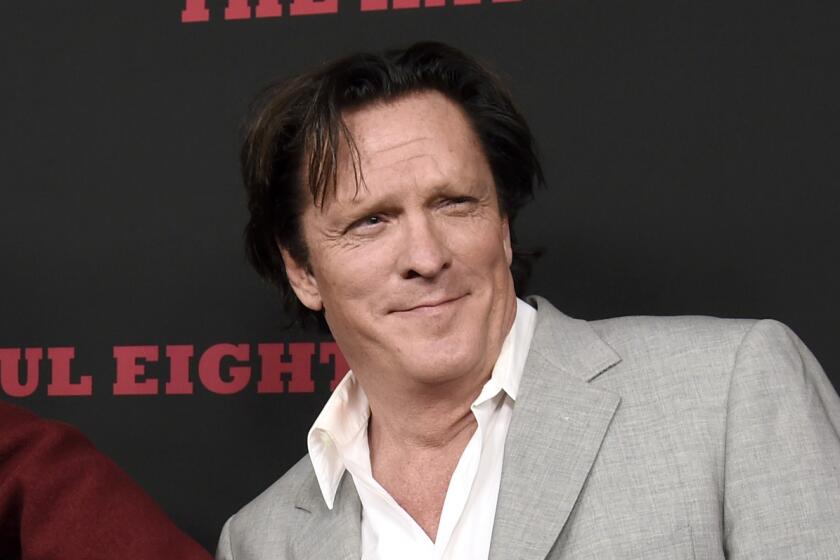Servant of a Troubled Master
- Share via
For Julia Roberts, curiously committed to pulling the longest possible string of long faces, starring in “Mary Reilly” must have seemed a fantasy fulfilled. Other viewers, however, are likely to feel less cause for celebration.
With a history extending through her last several films of being stubbornly sparing with her once famous but now AWOL smile, Roberts must have been delighted to come across a role that absolutely demanded she be glummer than Bob Dole from Frame 1 to the close.
Based on a novel by Valerie Martin that shrewdly retold Robert Louis Stevenson’s Victorian story of Dr. Jekyll and Mr. Hyde from the point of view of one of his female house servants, “Mary Reilly” begins with Roberts’ character on her hands and knees scrubbing the hard stone pavement with a damp cloth on a frighteningly gloomy day. It’s probably her happiest moment.
It’s not that Roberts is unconvincing as Mary Reilly. After all the practice she’s had lately, she can be miserable on-screen with the best of them and her performance is unassailable as far as it goes. But her unalloyed, unstoppable moroseness robs her character of any dimension and is symptomatic of any number of miscalculations that turned what seemed like a promising project into a grim reaper of a movie.
To be fair, aspects of that promise are still visible. “Mary Reilly,” which co-stars John Malkovich in the dual role, is rarely less than well-crafted, professionally directed by Stephen Frears and handsomely shot by Philippe Rousselot. Even the screenplay, written by Christopher Hampton (“Carrington,” “Dangerous Liaisons”), manages an occasional fine line, like this description of the troublesome Hyde: “He came out of the dark like he was made of it.”
But if there is nothing to be embarrassed about here, neither is there much to relish, for “Mary Reilly” has more of the sheen of art than its essence. Even its sleek monochromatic look (based on Edinburgh but largely reconstructed on a sound stage) is finally too repetitive, and a sense of sameness gradually creeps over everything like the stifling fog.
Part of the difficulty is that the core of “Mary Reilly’s” story--the trouble that the upstanding Dr. Jekyll gets into with his infernal scientific experimentation--is too familiar to stand its drawn-out presentation. There ought to be a limit as to how many bloody rags, unholy howls, late-night wanderings (by the doctor) and brutish behavior (by his mysterious laboratory assistant Hyde) a film is allowed, especially if there is a notable lack of mystery as to the cause.
What is supposed to make this retelling different is the addition of a romantic triangle. The good Henry Jekyll clearly has a crush on Mary Reilly, but he’s too much the proper gentleman to act on it. The seductive Hyde, his passionate alter ego, has no comparable compunctions, leading to the oddly modern conclusion that if Dr. Jekyll hadn’t been such a repressed Victorian and able to accept his feelings, none of this would have happened.
Though much attention is paid to her horrific, abuse-filled childhood, Mary Reilly’s drab and unvarnished misery makes her too uninteresting to be convincing as the object of anyone’s interest, least of all our own, and the cat-and-mouse games she ends up playing as she begins to suspect all is not well with the good doctor do not gain in interest with their repetition.
While Roberts’ performance is acceptable if uninviting, John Malkovich’s is not. As the pinched, repressed Dr. Jekyll, he completely fails to interest, and his libido-crazed Hyde would be more appropriate to a novel written by Fabio. Making even a worse impression is Glenn Close, who has a hammy cameo as a sneering, snarling madam named Mrs. Farraday, whose red lips provide one of the film’s few traces of color.
Sluggish and interminable, “Mary Reilly” makes good on little of its potential to be disturbing (an “Alien”-type unmasking sequence turns out especially silly) and none of its chance to be emotionally involving. Reports indicate that the entire film was shot without any agreed-upon plan for an ending, and the final product is so lacking in impact that’s not surprising. “Is evil stronger than good?” one of the film’s characters inevitably asks. If “Mary Reilly” is to be admitted as evidence, the answer is no, just more boring.
* MPAA rating: R, for notable gore and some strong violence. Times guidelines: a horror transformation scene reminiscent of “Alien.”
‘Mary Reilly’
Julia Roberts: Mary Reilly
John Malkovich: Dr. Jekyll/Mr. Hyde
George Cole: Mr. Poole
Michael Gambon: Mary’s father
Kathy Staff: Mrs. Kent
Glenn Close: Mrs. Farraday
Released by TriStar Pictures. Director Stephen Frears. Producers Ned Tanen, Nancy Graham Tanen, Norma Heyman. Executive producer Lynn Pleshette. Screenplay Christopher Hampton, based on the novel by Valerie Martin. Cinematographer Philippe Rousselot. Editor Lesley Walker. Costumes Consolata Boyle. Music George Fenton. Production design Stuart Craig. Art directors Michael Lamont, Jim Morahan. Set decorator Stephenie McMillan. Running time: 1 hour, 58 minutes.
* In general release throughout Southern California.
More to Read
Only good movies
Get the Indie Focus newsletter, Mark Olsen's weekly guide to the world of cinema.
You may occasionally receive promotional content from the Los Angeles Times.











